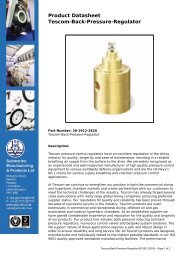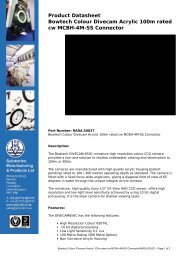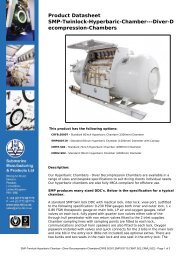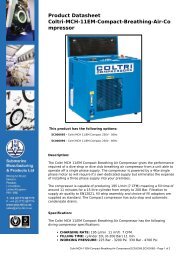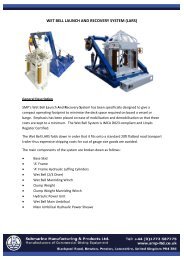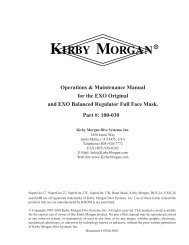Instruction Manual - DECA | Diving Equipment Company of America
Instruction Manual - DECA | Diving Equipment Company of America
Instruction Manual - DECA | Diving Equipment Company of America
Create successful ePaper yourself
Turn your PDF publications into a flip-book with our unique Google optimized e-Paper software.
THEORY OF OPERATION<br />
AUDIO VOLUME CONTROLS 7.3<br />
Microphone Volume Control<br />
The output <strong>of</strong> each INPUT AMPLIFIER CIRCUIT is attenuated through microphone volume control<br />
for the tender and each diver’s circuit. Each individual microphone signal can be adjusted before<br />
going to mixer U6-A and U6-B.<br />
Earphone Volume Control<br />
The output <strong>of</strong> the first filter circuit U7-A is attenuated through tender earphone volume control<br />
before signal go to Power Amplifier circuit.<br />
The output <strong>of</strong> the second filter circuit U7-B is attenuated through diver earphone volume control<br />
before signal go to Power Amplifier circuit.<br />
BATTERY CHARGER CARD, 2324-202 7.4<br />
The 2324-202 converts the AC power to a regulated DC voltage to operate the unit and charge the<br />
batteries. The charger card consists <strong>of</strong> Primary and Secondary Circuits, these two separated<br />
circuits are connected together through step down transformer.<br />
This Charger has a high level <strong>of</strong> insulation between Primary and Secondary circuits to prevent AC<br />
line to pass to the amplifier circuit in order to protect divers from electric shock. The Creepage<br />
Distance and Air Clearance on the charger meet UL2601-1 Medical Electrical <strong>Equipment</strong>s<br />
requirements. The transformer is split bobbin with high insulation between primary and secondary<br />
winding.<br />
The primary circuit detects AC line voltage (110 or 220), then activates latching relays K1 & K2 to<br />
select the proper transformer primary winding connections. On the primary circuit there are 2<br />
Micro fuses F1&F2 (400mA 250 Volt) have been mounted in socket holders. The fuses are small<br />
round cylinders mounted next to the AC cord connection, about the size <strong>of</strong> a pencil eraser. The<br />
Fuses are a single use safety device. They interrupt the current in the event <strong>of</strong> a massive short<br />
circuit. Consequently, a qualified technician should thoroughly investigate the cause <strong>of</strong> a blown<br />
fuse. The unit should be examined for the cause <strong>of</strong> the failure, and its safe operation verified<br />
before replacing the fuse and returning the unit to the field.<br />
The Secondary Circuit receives low voltage (20V AC) from transformer secondary winding then<br />
regulates the voltage at 14V DC. It automatically reduces the output voltage, in order to limit the<br />
maximum output current for charging the battery. It is designed to properly charge the internal<br />
battery without getting damage when battery is completely drained to zero. It protects batteries<br />
from overcharge by automatically switching to float charge <strong>of</strong> 13.8 To 14.0 Volts when batteries<br />
are fully charged. The secondary circuit provides low current to power front panel LED which<br />
indicates AC power is applied to unit.<br />
There is a fuse F3 in the secondary circuit located next to J2. If accidental reversing <strong>of</strong> internal<br />
battery terminals occurs, the fuse will blow to protect the electronic circuits and wires from<br />
damage. F3 fuse is replaceable with 3.15A-250V Slow Blow Micro Fuse.<br />
28



